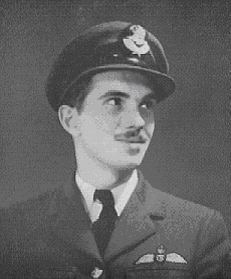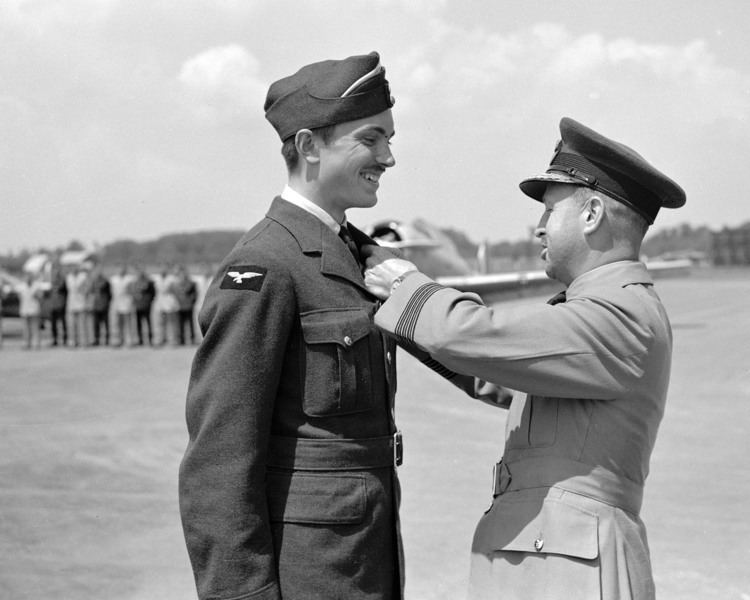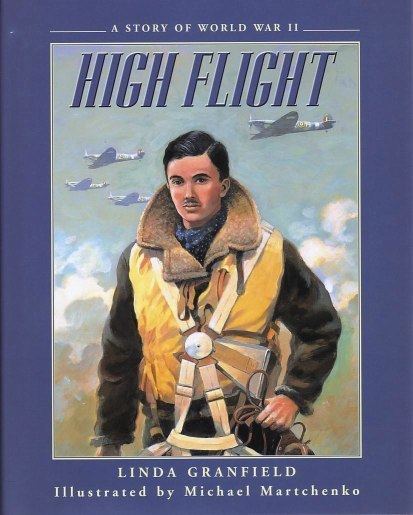Years of service 1940 – 1941 | Name John Magee, Rank Pilot officer Role Aviator Unit 412 Transport Squadron | |
 | ||
Education Avon Old Farms, Rugby School | ||
high flight by john gillespie magee jr poem animation
John Gillespie Magee Jr. (9 June 1922 – 11 December 1941) was an Anglo-American aviator and poet, made famous for his poem High Flight. Magee served in the Royal Canadian Air Force, which he joined before the United States entered the war; he died in a mid-air collision over Lincolnshire in 1941.
Contents
- high flight by john gillespie magee jr poem animation
- high flight by john gillespie magee jr read by tom o bedlam
- Early life
- Career
- Death
- High Flight
- Sources of inspiration
- Uses of the poem
- Musical adaptations
- Other use in the media
- Per Ardua
- References

high flight by john gillespie magee jr read by tom o bedlam
Early life

John Gillespie Magee was born in Shanghai, China, to an American father and a British mother, who both worked as Anglican missionaries. His father, John Magee, Sr., was from a family of some wealth and influence in Pittsburgh, Pennsylvania. Magee Senior chose to become an Episcopal priest and was sent as a missionary to China. Whilst there he met his future wife, Faith Emmeline Backhouse, who came from Helmingham in Suffolk and was a member of the Church Missionary Society. Magee's parents married in 1921, and their first child, John Junior, was born 9 June 1922, the eldest of four brothers.

Magee began his education at the American School in Nanking in 1929. In 1931 he moved with his mother to Britain and spent the following four years at St Clare, a preparatory school for boys, in Walmer, Kent.

He attended Rugby School from 1935 to 1939. He developed his poetry whilst at the school and in 1938 he won the school's Poetry Prize. He was deeply moved by the roll of honour of Rugby pupils who had fallen in the First World War. This list of the fallen included the celebrated war poet Rupert Brooke (1887–1915), whose work Magee greatly admired. Brooke had won the school poetry prize 34 years prior to Magee. The prize-winning poem by Magee referred to Brooke's burial at 11 o'clock at night in an olive grove on the Greek island of Skyros.
Whilst at Rugby, Magee met and fell in love with Elinor Lyon, the daughter of P. H. B. Lyon, the headmaster. She became the inspiration for many of Magee's poems. Though his love was not returned, he remained friends with Elinor and her family.
Magee visited the United States in 1939. Because of the outbreak of World War II, he was unable to return to Rugby for his final school year, and instead attended Avon Old Farms School in Avon, Connecticut. He earned a scholarship to Yale University in July 1940, but did not enroll, choosing instead to enlist in the Royal Canadian Air Force in October of that year.
Career
Magee joined the RCAF in October 1940 and received flight training in Ontario at No. 9 EFTS (Elementary Flying Training School), located at RCAF Station St. Catharines (St. Catharines), and at No. 2 SFTS (Service Flying Training School) at RCAF Station Uplands (Ottawa). He passed his Wings Test in June 1941.
Shortly after his promotion to the rank of Pilot Officer, after having been awarded his wings, Magee was sent to Britain. He was posted to No. 53 Operational Training Unit (OTU) at RAF Llandow, in Wales. After graduating from No. 53 OTU, Magee was assigned to No. 412 (Fighter) Squadron, RCAF, which was formed at RAF Digby on 30 June 1941, and where he became a qualified Spitfire pilot.
Death
Magee was killed at the age of 19, while flying Spitfire coded VZ-H, serial number AD291. He had taken off with other members of 412 Squadron from RAF Wellingore, a satellite station for RAF Digby. RAF Wellingore is near Navenby, about three miles northwest of RAF Cranwell; the airfield has now reverted to agriculture. The aircraft was involved in a mid-air collision with an Airspeed Oxford trainer from Cranwell, flown by Leading Aircraftman Ernest Aubrey Griffin. The two aircraft collided just below the cloud base at about 1,400 feet AGL, at 11:30, over the hamlet of Roxholme, which lies between RAF Cranwell and RAF Digby, in Lincolnshire. Magee was descending at high speed through a break in the clouds with three other aircraft.
At the inquiry afterwards a farmer testified that he saw the Spitfire pilot struggling to push back the canopy. The pilot jumped from the plane, but was too close to the ground for his parachute to open and died on impact. Griffin was also killed.
Magee was buried at Holy Cross Cemetery, Scopwick in Lincolnshire, England. On his grave are inscribed the first and last lines from his poem High Flight. Part of the official letter to his parents read, "Your son's funeral took place at Scopwick Cemetery, near Digby Aerodrome, at 2.30pm, on Saturday, 13 December 1941, the service being conducted by Flight Lieutenant S. K. Belton, the Canadian padre of this Station. He was accorded full Service Honours, the coffin being carried by pilots of his own Squadron".
High Flight
Magee's posthumous fame rests mainly on his sonnet High Flight, which he started on 18 August 1941, just a few months before his death, whilst he was based at No. 53 OTU. In his seventh flight in a Spitfire Mk I, he had flown up to 33,000 feet. As he orbited and climbed upward, he was struck by words he had read in another poem — "To touch the face of God." He completed his verse soon after landing.
Purportedly, the first person to read Magee's poem later that same day in the officers' mess, was his fellow Pilot Officer Michael Henry Le Bas (later Air Vice-Marshal M. H. Le Bas, CB CBE DSO AFC, Air Officer Commanding No. 1 Group RAF), with whom Magee had trained.
Magee enclosed the poem in a letter to his parents, dated 3 September 1941. His father, then curate of Saint John's Episcopal Church in Washington, DC, reprinted it in church publications. The poem became more widely known through the efforts of Archibald MacLeish, then Librarian of Congress, who included it in an exhibition of poems called "Faith and Freedom" at the Library of Congress in February 1942. The manuscript copy of the poem remains at the Library of Congress.
Sources of inspiration
The last words of High Flight — "...and touched the face of God" — can also be found in a poem by Cuthbert Hicks, published three years earlier in Icarus: An Anthology of the Poetry of Flight. The last two lines in Hicks' poem, The Blind Man Flies, are:
For I have danced the streets of heaven,And touched the face of God.The anthology includes the poem New World, by G. W. M. Dunn, which contains the phrase "on laughter-silvered wings". Dunn wrote of "the lifting mind", another phrase that Magee used in High Flight, and refers to "the shouting of the air", in comparison to Magee's line, "chased the shouting wind". Another line by Magee, "The high untrespassed sanctity of space", closely resembles "Across the unpierced sanctity of space", which appears in the anthology in the poem Dominion over Air, previously published in the RAF College Journal.
Uses of the poem
During April and May 1942, Hollywood stars such as Laurel and Hardy, Cary Grant, Bing Crosby, and Bob Hope joined the Hollywood Victory Caravan as it toured the United States on a mission to raise war bonds. Actress Merle Oberon recited High Flight as part of this show. During the performance on April 30, 1942, at the Loew's Capitol Theatre in Washington, D.C., and before her recitation of High Flight, Oberon acknowledged the attendance of his father, John Magee, and brother Christopher Magee.
Orson Welles recited the poem during an episode of Command Performance on December 21, 1943.
High Flight has been a favourite poem amongst both aviators and astronauts. It is the official poem of the Royal Canadian Air Force and the Royal Air Force and has to be recited from memory by fourth class cadets at the United States Air Force Academy, where it can be seen on display in the Cadet Field House. Portions of the poem appear on many of the headstones in the Arlington National Cemetery. It is displayed on panels at the Canadian War Museum in Ottawa, the National Air Force Museum of Canada, in Trenton, Ontario. It is the subject of a permanent display at the National Museum of the United States Air Force, in Dayton, Ohio. General Robert Lee Scott Jr. included it in his book God is My Co-Pilot.
Astronaut Michael Collins brought an index card with the poem typed on it on his Gemini 10 flight and included the poem in his autobiography Carrying The Fire. Former NASA Flight Director Gene Kranz quoted the first line of the poem in his book Failure Is Not An Option. U.S. President Ronald Reagan used part of High Flight in a speech written by Peggy Noonan, that followed the Challenger disaster on January 28, 1986.
At RAF Scampton in Lincolnshire, a memorial to Red Arrows pilots, Flight Lieutenants Jon Egging, killed 20 August 2011, and Sean Cunningham, killed 8 November 2011, bears an interpretation of the poem on a brass plaque atop a wooden plinth in front of a gate guardian aircraft outside the RAF Aerobatics Team hangar. The plaque reads "...they have slipped the surly bonds of Earth / Put out their hands and touched the face of God... / In memory of / Flt Lt Jon Egging - 20th August 2011 / Flt Lt Sean Cunningham - 8th November 2011".
Musical adaptations
Miklós Rózsa composed the earliest known setting of High Flight, for tenor voice, in 1942. It was later published as one of his Five Songs in 1974. Canadian composer and Royal Canadian Air Force veteran Robert J. B. Fleming wrote a through-composed musical setting of the poem for the Divine Services Book of the Canadian Armed Forces published in 1950. The composer Bill Pursell wrote his own arrangement with narration for the United States Air Force Band, which was broadcast on their radio show in the late 1940s. Several songs and symphonic compositions have been based on Magee's text, including Bob Chilcott's 2008 setting, premiered on 1 May 2008 by the King's Singers.
The poem has been set to music by several composers, including by John Denver as performed on the Bob Hope television show and is included in his 1983 album It's About Time and by Christopher Marshall, whose composition was commissioned for and premiered by The Orlando Chorale with saxophonist George Weremchuk (Orlando, Florida) in March 2009, under the direction of Gregory Ruffer. The first performance of a setting of words, known as "Even Such Is Time", from Fauré’s Requiem, plus additional non-liturgical texts that included High Flight, was performed by the Nantwich Choral Society, conducted by John Naylor, on Saturday 26 March 2011, in St Mary’s Church, Nantwich, Cheshire. The music was written by Andrew Mildinhall, the former organist at the church, who accompanied the performance with the Northern Concordia Orchestra.
The American composer James Curnow was commissioned by the Graduates Association of Tenri High School Band in Nara, Japan to write a piece for concert band in honor of the 50th anniversary of its association. The piece is entitled Where Never Lark or Eagle Flew with the subtitle "Based on a poem by John Gillespie Magee Jr." In 2012, the Australian composer Daniel Walker was commissioned by North Sydney Boys High School to compose a piece for the school's centenary celebrations. This composition, 'Through Footless Halls of Air', which was written for choir and symphonic winds, features the poem in the lyrics.
British composer Jonathan Dove included the poem in his 2009 oratorio There Was a Child, written as a memoriam to Robert Van Allen, who also died at the age of nineteen. It has also been set by British composer Nicholas Scott Burt as a short motet and dedicated to the choir of Rugby Parish Church.
In 2014, Canadian composer Vince Gassi composed a piece for concert band entitled Chase The Shouting Wind.
Other use in the media
Many U.S. television viewers were introduced to High Flight when some TV stations ended (and sometimes also began) their programming day with short films based on it. The sign-off film occasionally used by KCRA-TV in Sacramento, California featured the spoken poem played Air Force footage. Sung by Phill Driscoll. Phil is a trumpet player, Christian artist, and singer. In his rendition of the song, he alludes to being caught up to be with God. Other examples of the use of the poem in television programs, films include:
Per Ardua
Shortly after Magee's first combat action on November 8, 1941, he sent his family part of another poem, referring to it as "another trifle which may interest you". It is possible that the poem, Per Ardua, is the last that Magee wrote. There are several corrections to the poem, made by Magee, which suggest that the poem was not completed when he sent it. Per ardua ad astra ("Through adversity to the stars") is the motto of a number of Commonwealth air forces, such as the Royal Air Force, RAAF, RNZAF and the RCAF. It was first used in 1912 by the newly formed Royal Flying Corps.
